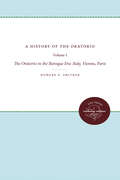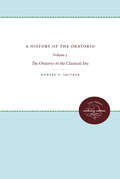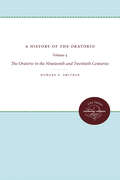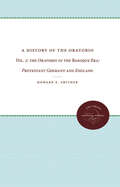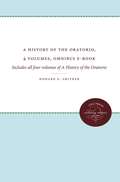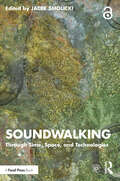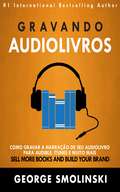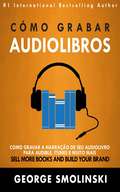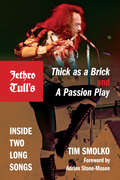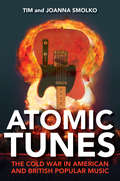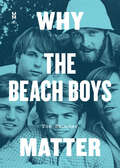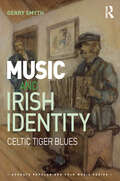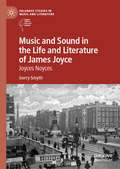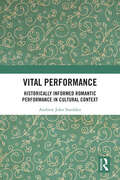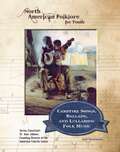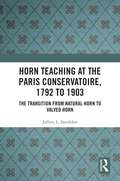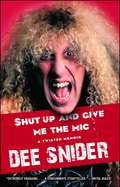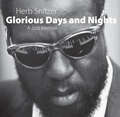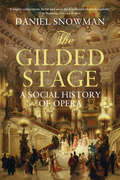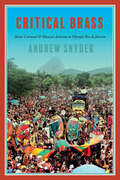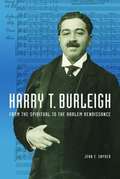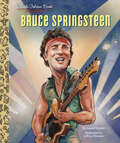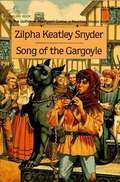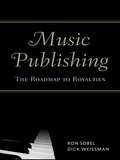- Table View
- List View
A History of the Oratorio: Vol. 1: The Oratorio in the Baroque Era: Italy, Vienna, Paris
by Howard E. SmitherHoward Smither has written the first definitive work on the history of the oratorio since Arnold Schering published his Geschichte des Oratoriums in 1911. This volume is the first of a four-volume comprehensive study that offers a new synthesis of what is known to date about the oratorio.Volume 1, divided into three parts, opens with the examination of the medieval, Renaissance, and early Baroque antecedents and origins of the oratorio, with emphasis on Rome and Philip Neri's Congregation of the Oratory and with special attention to the earliest works for which the term oratorio seems appropriate. The second part recounts the development of the oratorio in Italy, circa 1640-1720. It reviews the social contexts, patrons, composers, poets, librettos, and music of the oratorio in Italy, especially in Vienna and Paris. The procedure adapted throughout the work is to treat first the social context, particularly the circumstances of performance of the oratorio in a given area and period, then to treat the libretto, and finally the music. For each geographic area and period, the author has selected for special attention a few oratorios that appear to be particularly important or representative. He has verified the information offered in the specialized literature whenever possible by reference to the music or documents. In a number of areas, particular seventeenth-century Italy, in which relatively few previous studies have been undertaken or secondary sources have proven to be inadequate, the author has examined the primary sources in manuscript and printed form -- music, librettos, and documents of early oratorio history. Impressive research and intelligent integration of disparate elements make this complicated, diffuse subject both readable and accessible to the student of music.Volume 2, The Oratorio in the Baroque Era: Protestant Germany and England, and Volume 3, The Oratorio in the Classical Era, continue and expand the study of oratorio history. Although this series was originally announced as a three-volume study, Smither will conclude with a fourth volume.This new work--the first English-language study of the history of the oratorio will become the standard work on its subject and an enduring contribution to music and scholarship.Originally published in 1977.A UNC Press Enduring Edition -- UNC Press Enduring Editions use the latest in digital technology to make available again books from our distinguished backlist that were previously out of print. These editions are published unaltered from the original, and are presented in affordable paperback formats, bringing readers both historical and cultural value.
A History of the Oratorio: Vol. 3: the Oratorio in the Classical Era
by Howard E. SmitherThe Oratorio in the classical Era is the third volume of Howard Smither's monumental History of the Oratorio, continuing his synthesis and critical appraisal of the oratorio. His comprehensive study surpasses in scope and treatment all previous works on the subject. A fourth and final volume, on the oratorio in the nineteenth and twentieth centuries, is forthcoming.In this volume Smither discusses the Italian oratorio from the 1720s to the early nineteenth century and oratorios from other parts of Europe from the 1750s to the nineteenth century. Drawing on works that represent various types, languages, and geographical areas, Smither treats the general characteristics of oratorio libretto and music and analyzes twenty-two oratorios from Italy, England, Germany, France, and Russia. He synthesizes the results of specialized studies and contributes new material based on firsthand study of eighteenth-century music manuscripts and printed librettos. Emphasizing the large number of social contexts within which oratorios were heard, Smither discussed examples in Italy such as the Congregation of the Oratory, lay contrafraternities, and educational institutions. He examines oratorio performances in German courts, London theaters and English provincial festivals, and the Parisian Concert spirituel. Though the volume concentrates primarily on eighteenth-century oratorio from the early to the late Classical styles, Smither includes such transitional works as the oratorios of Jean-Francios le Seur in Paris and Stepan Anikievich Degtiarev in Moscow.A History of the Oratorio is the first full-length history of the genre since Arnold Schering's 1911 study. In addition to synthesizing current thought about the oratorio, this volume contributes new information on relationships between oratorio librettos and contemporary literary and religious thought, and on the musical differences among oratorios from different geographical-cultural regions.Originally published in 1987.A UNC Press Enduring Edition -- UNC Press Enduring Editions use the latest in digital technology to make available again books from our distinguished backlist that were previously out of print. These editions are published unaltered from the original, and are presented in affordable paperback formats, bringing readers both historical and cultural value.
A History of the Oratorio: Vol. 4: The Oratorio in the Nineteenth and Twentieth Centuries
by Howard E. SmitherWith this volume, Howard Smither completes his monumental History of the Oratorio. Volumes 1 and 2, published by the University of North Carolina Press in 1977, treated the oratorio in the Baroque era, while Volume 3, published in 1987, explored the genre in the Classical era. Here, Smither surveys the history of nineteenth- and twentieth-century oratorio, stressing the main geographic areas of oratorio composition and performance: Germany, Britain, America, and France.Continuing the approach of the previous volumes, Smither treats the oratorio in each language and geographical area by first exploring the cultural and social contexts of oratorio. He then addresses aesthetic theory and criticism, treats libretto and music in general, and offers detailed analyses of the librettos and music of specific oratorios (thirty-one in all) that are of special importance to the history of the genre.As a synthesis of specialized literature as well as an investigation of primary sources, this work will serve as both a springboard for further research and an essential reference for choral conductors, soloists, choral singers, and others interested in the history of the oratorio.Originally published 2000.A UNC Press Enduring Edition -- UNC Press Enduring Editions use the latest in digital technology to make available again books from our distinguished backlist that were previously out of print. These editions are published unaltered from the original, and are presented in affordable paperback formats, bringing readers both historical and cultural value.
A History of the Oratorio: Vol. 2: the Oratorio in the Baroque Era: Protestant Germany and England
by Howard E. SmitherWritten by an eminent scholar in a style that represents American musicological writing at its communicative best, A History of the Oratorio offers a synthesis and critical appraisal so exhaustive and reliable that the serious student of the oratorio will be compelled to look to these volumes as an indispensable source. No work on the history of the oratorio has yet appeared in the English language that is comparable in scope and treatment with Howard Smither's comprehensive four-volume work.The first part of volume 2 examines in depth the antecedents and origins of the oratorio in Protestant Germany in the seventeenth century. It includes discussions of the Lutheran Historia, sacred dramatic dialogues, and the Lubeck Abendmusiken of Buxtehude. The second part treats the oratorio in Protestant Germany in the early eighteenth century and examines Handel, Reinhard Keiser, and J.S. Bach. The third part considers primarily the English oratorios of Handel. In most sections of A History of the Oratorio, the author has selected for special attention a few oratorios that are representative of each geographical area and period. An exception to this procedure is in the section on Handel in this volume, where all of the composer's English oratorios are treated fully with particular reference to recent specialized Handel studies.Volume 1, The Oratorio in the Baroque Era: Italy, Vienna, Paris, and Volume 3, The Oratorio in the classical Era, expand and continue the study of oratorio history. Although this series was originally announced as a three-volume study, Smither will conclude with a fourth volume.Originally published in 1977. A UNC Press Enduring Edition -- UNC Press Enduring Editions use the latest in digital technology to make available again books from our distinguished backlist that were previously out of print. These editions are published unaltered from the original, and are presented in affordable paperback formats, bringing readers both historical and cultural value.
A History of the Oratorio, 4 volumes, Omnibus E-book
by Howard E. SmitherThe University of North Carolina Press is proud to announce Howard Smither's ground-breaking four-volume A History of the Oratorio, are now available in one convenient Omnibus E-Book edition. Published as UNC Press Enduring Editions, these volumes bring Smither's landmark scholarship to a new generation of readers and scholars.Written by an eminent scholar in a style that represents American musicological writing at its communicative best, A History of the Oratorio offers a synthesis and critical appraisal so exhaustive and reliable that the serious student of the oratorio will be compelled to look to these volumes as an indispensable source. No work on the history of the oratorio has yet appeared in the English language that is comparable in scope and treatment with Smither's comprehensive four-volume work.Volumes 1 and 2, published by the University of North Carolina Press in 1977, treated the oratorio in the Baroque era, while Volume 3, published in 1987, explored the genre in the Classical era. The final volume, Volume 4, published in 2000, surveys the history of nineteenth- and twentieth-century oratorio, stressing the main geographic areas of oratorio composition and performance: Germany, Britain, America, and France.A History of the Oratorio is the first full-length history of the genre since Arnold Schering published his Geschichte des Oratoriums in 1911. In addition to synthesizing current thought about the oratorio, these volumes contribute new information on relationships between oratorio librettos and contemporary literary and religious thought, and on the musical differences among oratorios from different geographical-cultural regions.Information on the 4 volumes included in this Omnibus E-Book:A HISTORY OF THE ORATORIOHoward E. SmitherVolume 1: The Oratorio in the Baroque Era: Italy, Vienna, Paris507 pp., 59 illus., 74 music examplesVolume 2: the Oratorio in the Baroque Era: Protestant Germany and England415 pp., 48 illus., 75 music examplesVolume 3: the Oratorio in the Classical Era736 pp., 37 illus., 30 tables, 110 music examplesVolume 4: The Oratorio in the Nineteenth and Twentieth Centuries856 pp., 24 illus., 33 tables, 90 figs.About UNC Press Enduring Editions UNC Press Enduring Editions use the latest in digital technology to make available again books from our distinguished backlist that were previously out of print. These editions are published unaltered from the original, and are presented in affordable paperback formats, bringing readers both historical and cultural value.
Soundwalking: Through Time, Space, and Technologies
by Jacek SmolickiSoundwalking brings together a diverse group of contemporary scholars, artists and thinkers in one of the first comprehensive studies of soundwalking – the practice of moving through space while carefully listening to what it has to say – to address urgent challenges and concerns of an environmental, ethical, social and technological nature. Besides gaining insight into the historical development of soundwalking as a scholarly method and artistic genre, the reader will have a chance to learn from emerging voices concerned with this practice, of many different backgrounds and positionalities. Soundwalking demonstrates how attentive listening and walking might help with more careful and responsible navigation through the complex dimensions of our shared environments and entangled histories, often imperceptible on a day-to-day basis. The book encourages scholars, artists, and also those unfamiliar with the concept, to engage with it in their respective fields and subjects of interest as an interdisciplinary method of critical inquiry and a creative mode of communication. This book inspires readers to discover anew the potential of walking and listening, and will be of interest to students, researchers and practitioners in the areas of studies directly concerned with sound and beyond, including environmental humanities, arts, design, landscape architecture, media, and cultural studies.
Gravando audiolivros: Como gravar a narração de seu audiolivro para Audible, iTunes e muito mais
by George Smolinski Mariana BaroniComo gravar a narração de seu audiolivro para a Audible, o iTunes e muito mais! Venda mais livros e construa sua marca! Áudio está na moda! Não é nenhum segredo que, seja por podcasts ou em audiolivros, as pessoas queiram escutar a conteúdo tanto quanto queiram vê-lo ou lê-lo. Comece a gravar seu próprio audiolivro com este livro! Este é um guia completo com instruções em vídeo que permitirão que você grave seu próprio audiolivro. Eu sei porque usei ESSAS MESMAS TÉCNICAS PARA GRAVAR este mesmo livro para a Audible! Os audiolivros são a maior tendência em publicação hoje. Houve um crescimento explosivo nas vendas de audiolivros nos últimos 4 anos e você precisa transformar seu livro em formato audiolivro hoje. Este guia o ensinará os prós e contras da gravação de audiolivros, mesmo se você quiser gravar sozinho a narração de seu audiolivro. O que este guia discutirá: 1. Qual equipamento você precisará para gravar seus audiolivros e narrações; 2. Como começar a gravar audiolivros com os software GarageBand e Audacity; 3. Dicas e truques que o ajudarão a começar com o pé direito a narração do audiolivro; 4. Como fazer upload de seu livro finalizado para Audible e o iTunes; 5. Recursos úteis para terceirizar a produção de seu audiolivro se você não for do tipo “faça você mesmo”. Entre na onda dos audiolivros e aprenda como gravar os seus hoje mesmo!
Cómo grabar audiolibros
by George Smolinski M. Celeste Espina¡El audio es fantástico! No es ninguna novedad el hecho de que, ya sea en podcast o en audiolibros, la gente prefiere escuchar contenido más que verlo o leerlo. ¡Comience a grabar su propio audiolibro! Esta es una completa guía con instrucciones en video que le permitirán crear su propio producto. ¡Lo sé porque yo utilicé ÉSTAS MISMAS TÉCNICAS para grabar este libro para Audible! Los audiolibros son hoy la tendencia más candente en edición. Hubo un crecimiento explosivo en las ventas de audiolibros durante los últimos cuatro años, y hoy usted necesita tener su libro en este formato. Esta guía le enseñará los pormenores de la creación de audiolibros, ¡incluso si desea hacer la grabación usted mismo! Ésta guía abarca: 1. Qué equipamiento necesitará para la grabación y narración de su libro. 2. Cómo comenzar a grabar con los softwares GarageBand y Audacity. 3. Trucos y consejos para ayudarlo a comenzar con buen pie en la narración de audiolibros. 4. Cómo subir su libro terminado a Audible y a iTunes. 5. Recursos útiles para externalizar su producción en el caso de que usted no sea una persona hábil para el "hágalo usted mismo". ¡Súbase al carro de los audiolibros y aprenda a realizarlos hoy mismo!
Jethro Tull's Thick as a Brick and A Passion Play
by Tim SmolkoSince the 1960s, British progressive rock band Jethro Tull has pushed the technical and compositional boundaries of rock music by infusing its musical output with traditions drawn from classical, folk, jazz, and world music. The release of Thick as a Brick (1972) and A Passion Play (1973) won the group legions of new followers and topped the Billboard charts in the United States, among the most unusual albums ever to do so. Tim Smolko explores the large-scale form, expansive instrumentation, and complex arrangements that characterize these two albums, each composed of one continuous song. Featuring insights from Ian Anderson and in-depth musical analysis, Smolko discusses the band's influence on popular culture and why many consider Thick as a Brick and A Passion Play to be two of the greatest concept albums in rock history.
Atomic Tunes: The Cold War in American and British Popular Music
by Tim Smolko Joanna SmolkoWhat is the soundtrack for a nuclear war? During the Cold War, over 500 songs were written about nuclear weapons, fear of the Soviet Union, civil defense, bomb shelters, McCarthyism, uranium mining, the space race, espionage, the Berlin Wall, and glasnost. This music uncovers aspects of these world-changing events that documentaries and history books cannot. In Atomic Tunes, Tim and Joanna Smolko explore everything from the serious to the comical, the morbid to the crude, showing the widespread concern among musicians coping with the effect of communism on American society and the threat of a nuclear conflict of global proportions. Atomic Tunes presents a musical history of the Cold War, analyzing the songs that capture the fear of those who lived under the shadow of Stalin, Sputnik, mushroom clouds, and missiles.
Why the Beach Boys Matter (Music Matters)
by Tom Smucker&“An excellent introduction to the band that might have evolved, [the author] suggests, into the Beatles.&” —New York Journal of Books Of all the white American pop music groups that hit the charts before the Beatles, only the Beach Boys continued to thrive throughout the British Invasion to survive into the 1970s and beyond. The Beach Boys helped define both sides of the era we broadly call the sixties, split between their early surf, car, and summer pop and their later hippie, counterculture, and ambitious rock. No other group can claim the Ronettes and the Four Seasons as early 1960s rivals; the Mamas and the Papas and Crosby, Stills and Nash as later 1960s rivals; and the Beatles and the Temptations as decade-spanning counterparts. This is the first book to take an honest look at the themes running through the Beach Boys&’ art and career as a whole and to examine where they sit inside our culture and politics—and why they still grab our attention.
Why the Beach Boys Matter (Music Matters)
by Tom Smucker“An excellent introduction to the band that might have evolved, [the author] suggests, into the Beatles.” ?New York Journal of BooksOf all the white American pop music groups that hit the charts before the Beatles, only the Beach Boys continued to thrive throughout the British Invasion to survive into the 1970s and beyond. The Beach Boys helped define both sides of the era we broadly call the sixties, split between their early surf, car, and summer pop and their later hippie, counterculture, and ambitious rock. No other group can claim the Ronettes and the Four Seasons as early 1960s rivals; the Mamas and the Papas and Crosby, Stills and Nash as later 1960s rivals; and the Beatles and the Temptations as decade-spanning counterparts.This is the first book to take an honest look at the themes running through the Beach Boys’ art and career as a whole and to examine where they sit inside our culture and politics—and why they still grab our attention.
Music and Irish Identity: Celtic Tiger Blues (Ashgate Popular and Folk Music Series)
by Gerry SmythMusic and Irish Identity represents the latest stage in a life-long project for Gerry Smyth, focusing here on the ways in which music engages with particular aspects of Irish identity. The nature of popular music and the Irish identity it supposedly articulates have both undergone profound change in recent years: the first as a result of technological and wider industrial changes in the organisation and dissemination of music as seen, for example, with digital platforms such as YouTube, Spotify and iTunes. A second factor has been Ireland’s spectacular fall from economic grace after the demise of the "Celtic Tiger", and the ensuing crisis of national identity. Smyth argues that if, as the stereotypical association would have it, the Irish have always been a musical race, then that association needs re-examination in the light of developments in relation to both cultural practice and political identity. This book contributes to that process through a series of related case studies that are both scholarly and accessible. Some of the principal ideas broached in the text include the (re-)establishment of music as a key object of Irish cultural studies; the theoretical limitations of traditional musicology; the development of new methodologies specifically designed to address the demands of Irish music in all its aspects; and the impact of economic austerity on musical negotiations of Irish identity. The book will be of seminal importance to all those interested in popular music, cultural studies and the wider fate of Ireland in the twenty-first century.
Music and Sound in the Life and Literature of James Joyce: Joyces Noyces (Palgrave Studies in Music and Literature)
by Gerry SmythMusic and Sound in the Life and Literature of James Joyce: Joyces Noyces offers a fresh perspective on the Irish writer James Joyce’s much-noted obsession with music. This book provides an overview of a century-old critical tradition focused on Joyce and music, as well as six in-depth case studies which revisit material from the writer’s career in the light of new and emerging theories. Considering both Irish cultural history and the European art music tradition, the book combines approaches from cultural musicology, critical theory, sound studies and Irish studies. Chapters explore Joyce’s use of repetition, his response to literary Wagnerism, the role and status of music in the aesthetic and political debates of the fin de siècle, music and cultural nationalism, ubiquitous urban sound and ‘shanty aesthetics’. Gerry Smyth revitalizes Joyce’s work in relation to the ‘noisy’ world in which the author wrote (and his audience read) his work.
Vital Performance: Historically Informed Romantic Performance in Cultural Context
by Andrew SneddenHistorically Informed Performance, or HIP, has become an influential and exciting development for scholars, musicians, and audiences alike. Yet it has not been unchallenged, with debate over the desirability of its central goals and the accuracy of its results. The author suggests ways out of this impasse in Romantic performance style. In this wide-ranging study, pianist and scholar Andrew John Snedden takes a step back, examining the strengths and limitations of HIP. He proposes that many problems are avoided when performance styles are understood as expressions of their cultural era rather than as simply composer intention, explaining not merely how we play, but why we play the way we do, and why the nineteenth century Romantics played very differently. Snedden examines the principal evidence we have for Romantic performance style, especially in translation of score indications and analysis of early recordings, finally focusing on the performance styles of Liszt and Chopin. He concludes with a call for the reanimation of culturally appropriate performance styles in Romantic repertoire. This study will be of great interest to scholars, performers, and students, to anyone wondering about how our performances reflect our culture, and about how the Romantics played their own culturally-embedded music.
Campfire Songs, Ballads, and Lullabies: Folk Music (North American Folklore for Youth)
by Gus SnedekerYou may turn on the CD player or the radio when you want to hear music--but once, in the days before modern technology, music was enjoyed whenever groups of people got together. You probably know some folk songs, a song that was passed along from person to person. Learn about: * types of folk songs * folk instruments * folk music's European and African roots * Cajun music * the music of Appalachia * Hispanic music * today's folk music. Modern music--Rock, Country, R&B, and more--is rooted deep in North America's musical folklore. And folk music is still alive and well today.
Horn Teaching at the Paris Conservatoire, 1792 to 1903: The Transition from Natural Horn to Valved Horn
by Jeffrey L. SnedekerThe transition from the valveless natural horn to the modern valved horn in 19th-century Paris was different from similar transitions in other countries. While valve technology was received happily by players of other members of the brass family, strong support for the natural horn, with its varied color palette and virtuoso performance traditions, slowed the reception and application of the valve to the horn. Using primary sources including Conservatoire method books, accounts of performances and technological advances, and other evidence, this book tells the story of the transition from natural horn to valved horn at the Conservatoire, from 1792 to 1903, including close examination of horn teaching before the arrival of valved brass in Paris, the initial reception and application of this technology to the horn, the persistence of the natural horn, and the progression of acceptance, use, controversies, and eventual adoption of the valved instrument in the Parisian community and at the Conservatoire. Active scholars, performers, and students interested in the horn, 19th-century brass instruments, teaching methods associated with the Conservatoire, and the intersection of technology and performing practice will find this book useful in its details and conclusions, including ramifications on historically-informed performance today.
Shut Up and Give Me the Mic
by Dee SniderDEE'S NOT GONNA TAKE IT As lead singer and songwriter of Twisted Sister, Dee Snider became the poster boy for heavy metal, hair bands, and the wild side of rock. Now, in his twisted new memoir, he reveals the real stories behind the crazy makeup, the big hair, and badass hits like "We're Not Gonna Take It" and "I Wanna Rock." A classically trained countertenor who sang with his high school choir, Dee remembers the day he decided he was "not gonna take it" and stopped caring what people thought about him. Following in the footsteps of his idols Alice Cooper and Black Sabbath, Dee jumped from band to band before meeting Jay Jay French and Twisted Sister. But it wasn't until he met his costume-designing soul-mate Suzette that they developed his unique style. Dee's hard work finally paid off with an impressive resume that includes: a monster hit record; smash MTV videos; a long-running radio show, "The House of Hair"; appearances in film (Pee Wee's Big Adventure, Howard Stern's Private Parts, StrangeLand) and television (Growing Up Twisted, Celebrity Apprentice); and a starring role in Broadway's Rock of Ages. He even authored a teenage survival guide that was required reading in Russia! In his journey from every parent's worst teenage nightmare to Renaissance man, Dee avoided the usual pitfalls associated with rock stars. But that didn't stop Tipper Gore and the Parents Music Resource Center from targeting him--a fight that led him to testify before Congress with Frank Zappa. He may have been slapped with a Parental Advisory warning label, but, through it all, Dee stayed positive and focused on being the best he could be. Filled with entertaining anecdotes and candid confessions, Shut Up and Give Me the Mic takes you through the good times and bad with a heavy metal star who worked as hard as he played, and who did it all for his wife, four kids, and millions of "SMF" (Sick Mother F******) fans This story is mine. I'm the guy that gave it all to beat the odds, left everything he had on the stage each night, didn't screw around on his woman, took care of his kids, and was sober enough to remember it all and write about it . . . myself. The one thing that has surprised and confused me, though, is my unlikely transformation into a "beloved public figure." How did the unpopular kid, who grew up to be the angry young man, who became the '80s poster boy for the evils of rock 'n' roll, arrested for profanity and assault, and boycotted by parents and religious groups, become the likeable mensch he is today?
Glorious Days and Nights: A Jazz Memoir
by Herb SnitzerGlorious Days and Nights is a personal account of the fifty-year career of jazz photographer Herb Snitzer, with a special focus on his years in New York City from 1957 to 1964. A photojournalist for Life, Look, and Fortune, Snitzer was the photo editor and later associate editor of the influential jazz magazine Metronome. During the 1960s, politics, race, and social strife and unrest swirled in Snitzer's life as a working artist. But throughout the bus boycotts, demonstrations, civil and racial unrest, what remained constant for him was jazz. Snitzer recalls what it was like to go on the road with these musicians. His reflections run the gamut from serious meditations on his development as a young photographer working with musicians already of great stature to more conversational recollections of casual moments spent having fun with the jazz artists many of whom became close friends. This book includes Snitzer's very best jazz photographs. He reveals the essences of the artists, their struggles, joys, and pains. A number of Snitzer's jazz images have become iconic, including Louis Armstrong with the Star of David, Lester Young at The Five Spot Café in New York City, John Coltrane reflected in a mirror, Thelonious Monk with piano keys reflected in his sunglasses, and Miles Davis at Newport. With eighty-five black-and-white images of jazz giants, Glorious Days and Nights provides a long-awaited testimony to the friendships and artistry that Snitzer developed over his remarkable career.
The Gilded Stage: A Social History of Opera
by Daniel SnowmanFascinating and highly readable, this is the definitive social history of the world's most romantic, flamboyant, glamorous, and politically influential art-form: opera From its beginnings in the Renaissance cities of northern Italy opera has permeated through Europe, America, and beyond, becoming a global business in the digital age. This history unwraps the story of opera from the charm and chaos of Mozart's Vienna to Frederick the Great's Berlin. It covers the lure of fin-de-siècle Paris, the rough and tumble of the Australian outback, and the new world of the Americas—colorful backdrops to the always dramatic, sometimes tragic, sometimes hilarious episodes that make up this rich and fascinating story.
Critical Brass: Street Carnival and Musical Activism in Olympic Rio de Janeiro (Music / Culture)
by Andrew SnyderCritical Brass tells the story of neofanfarrismo, an explosive carnival brass band community turned activist musical movement in Rio de Janeiro, as Brazil shifted from a country on the rise in the 2000s to one beset by various crises in the 2010s. Though predominantly middle-class, neofanfarristas have creatively adapted the critical theories of carnival to militate for a more democratic city. Illuminating the tangible obstacles to musical movement building, Andrew Snyder argues that festive activism with privileged origins can promote real alternatives to the neoliberal city, but meets many limits and contradictions in a society marked by diverse inequalities.
Harry T. Burleigh: From the Spiritual to the Harlem Renaissance
by Jean E SnyderHarry T. Burleigh (1866-1949) played a leading role in American music and culture in the twentieth century. Celebrated for his arrangements of spirituals, Burleigh was also the first African American composer to create a significant body of art song. An international roster of opera and recital singers performed his works and praised them as among the best of their time. Jean E. Snyder traces Burleigh's life from his Pennsylvania childhood through his fifty-year tenure as soloist at St. George's Episcopal Church in Manhattan. As a composer, Burleigh's pioneering work preserved and transformed the African American spiritual; as a music editor, he facilitated the work of other black composers; as a role model, vocal coach, and mentor, he profoundly influenced American song; and in private life he was friends with AntonÃn DvoÅTMák, Marian Anderson, Will Marion Cook, and other America luminaries. Snyder provides rich historical, social, and political contexts that explore Burleigh's professional and personal life within an era complicated by changes in race relations, class expectations, and musical tastes.
Bruce Springsteen A Little Golden Book Biography (Little Golden Book)
by Laurel SnyderHelp your little one dream big with a Little Golden Book biographyabout Bruce Springsteen, "The Boss" of rock music. Little Golden Book biographies are the perfect introduction to nonfiction for young readers—as well as fans of all ages!This Little Golden Book about Bruce Springsteen--one of America's most iconic singer-songwriters, and 20-time Grammy Award-winner--is an inspiring read-aloud for young children, as well as their parents and grandparents who are fans of The Boss.Look for more Little Golden Book biographies: • Willie Nelson • Beyoncé • Dolly Parton • Taylor Swift • Tony Bennett
Song of the Gargoyle
by Zilpha Keatley SnyderA strange sound awakens thirteen-year-old Tymmonin in the dead of night. In a blink of an eye his father, the court jester of Austerneve, is mysteriously kidnapped and the terrified boy must slip away secretly to avoid capture himself.
Music Publishing: The Roadmap to Royalties
by Ron Sobel Dick WeissmanMusic Publishing covers the basics of how a composition is copyrighted, published, and promoted. Publishing in the music business goes far beyond the physical sheet--it includes live performance and mechanical (recording) rights, and income streams from licensing deals of various kinds. A single song can generate over thirty different royalty streams, and a writer must know how these royalties are calculated and who controls the flow of the money. Taking a practical approach, the authors -- one a successful music publisher and attorney, the other a songwriter and music business professor -- explain in simple terms the basic concept of copyright law as it pertains to compositions. Throughout, they give practical examples from "real world" situations that illuminate both potential pitfalls and possible upsides for the working composers.
